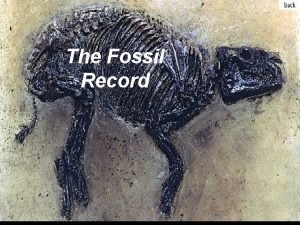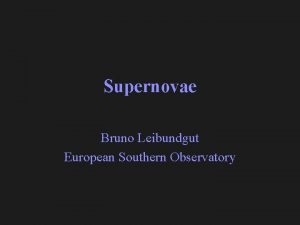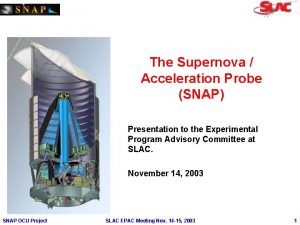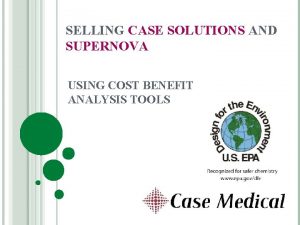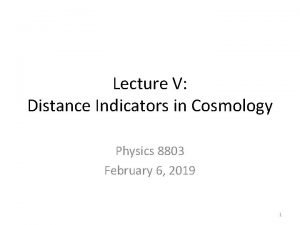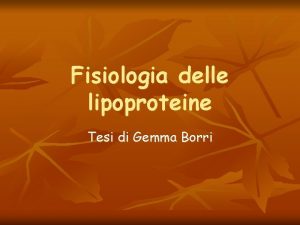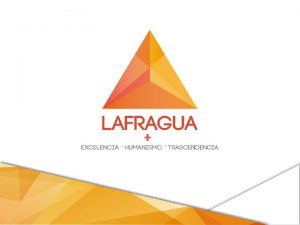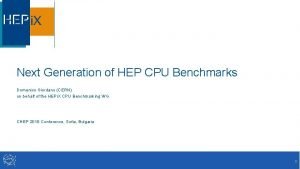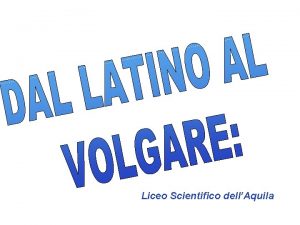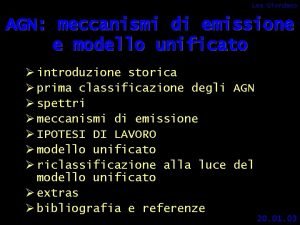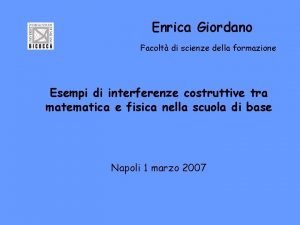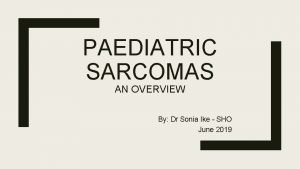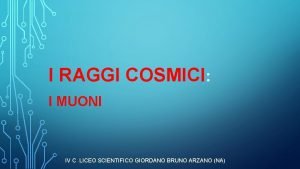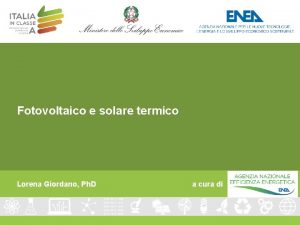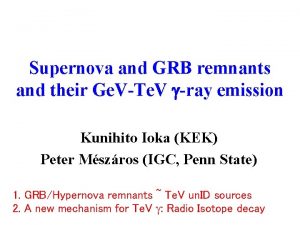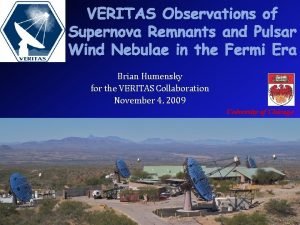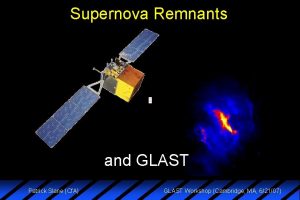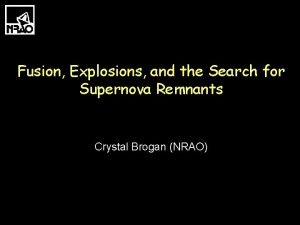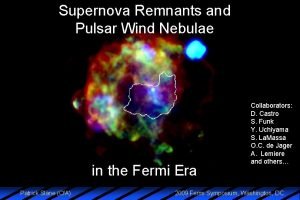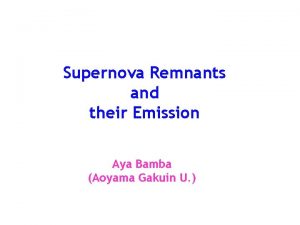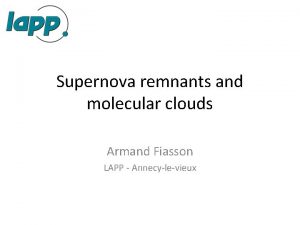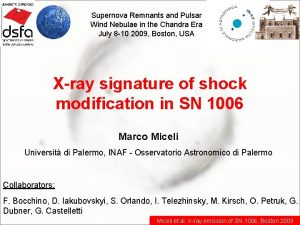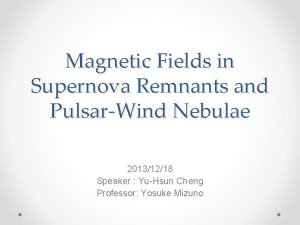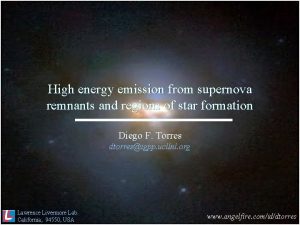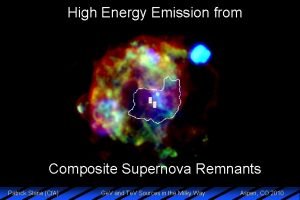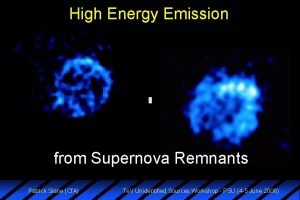Supernova Remnants HE Francesco Giordano University and INFN





























- Slides: 29

Supernova Remnants @ HE Francesco Giordano University and INFN Bari Gamma 400 Workshop

Outline • Why @ HE (Emission Processes) • How Many @ HE (Towards the 1 st Catalog) • How Good (Study of systematic errors) • Different Families? • Conclusions 3/5/2013 F. Giordano @ Gamma 400 2

A “Typical” SNR SED n. H=100 cm-3 Kep=10 -1 Eb=10 Te. V 1=2 2=4. 5 B=100 u. G Fermi Range 0 Br e S m c yn on C I B CM n. H=1 cm-3 Scaling the environment density we pass from a p-p dominated SED to a IC dominated 3/5/2013 F. Giordano @ Gamma 400 3

Populations 3/5/2013 F. Giordano @ Gamma 400 4

Synchrotron radiation Zirakashvili and Aharonian (2007) A&A 465 ωc = 1. 5 Bp 2/(mc)3 3/5/2013 F. Giordano @ Gamma 400 5

IC Scattering Stuner et al. (1997) Ap. J 490 • U = 0. 26 e. V/cm 3 • T = 2. 73 K 3/5/2013 F. Giordano @ Gamma 400 6

Cosmic Microwave Background We used the following expression for the number density of CMB photon as a function of energy (blackbody photon distribution): where: • k is the Boltzmann constant and T = 2. 73 K; • The parameter U represents the energy density of CMB photons and it is equal to 0. 26 e. V cm-3. If we integrate over all values of energy we obtain the value of the number density: 3/5/2013 F. Giordano @ Gamma 400 7

Bremsstrahlung yield Baring et al. (2000) Ap. J 528 Density of environment Bethe-Heitler ultra-relativistic Cross Section 3/5/2013 F. Giordano @ Gamma 400 8

p-p interactions via 0 decay Parameterization proposed by Kamae et al 2006 3/5/2013 F. Giordano @ Gamma 400 9

Fermi-Detected SNRs 1 3 i d e n t i f i e d S N R Tycho 3/5/2013 Cygnus Loop CTB 37 A F. Giordano @ Gamma 400 counts Vela Jr 10

Detection of the p 0 -decay bump in SNRs IC 443 and W 44 are the two brightest SNRs in the Fermi-LAT range • The low energy break is very significant M. Ackermann et al. 2013 (~19σ and ~21σ for 60 Me. V E 2 Ge. V); • This gives unambiguous and robust detection of the pion decay bump • and clear proof that these SNRs accelerate protons. 3/5/2013 F. Giordano @ Gamma 400 11

Fermi-Detected SNRs + 1 3 4 3 i d e n t i f i e d S N R 2 F G L 3/5/2013 c a n d i d F. Giordano @ Gamma 400 aounts c 12

SNR Catalog: To better understand SNRs in a statistically significant manner within a MW context we: ● ● ● characterize the spatial and spectral morphology of all regions containing known SNRs. examine multi-wavelength (MW) correlation, including spectrum + morphology for radio, X-ray, and Te. V and CO, maser, IR, … determine statistically significant SNR classification(s) and perform spectral modeling 3/5/2013 F. Giordano @ Gamma 400 13

Characterize Ge. V Emission: Analysis Procedure Data Set: 3 years of P 7 SOURCE_V 6 LAT data • E: 1 -100 Ge. V • Region Of Interest: 10° around each SNR • Green’s Catalog (2009): • 274+5 SNRs Starting Model: • 2 FGL Overlapping sources? = None: Add a new extended source = 1 source (not PSR): Replace w extended source • > 1 source: Replace (non-PSR) source closest to radio centroid w extended source. Delete all other (non-PSR) sources. • • Localize source, fit extension • • • Disk extension seed = radio size Spectral model: power law Normalization of Galactic diffuse and all sources w/in 5 o of candidate are free during minimization procedure. Identifying SNRs via extension: If a SNR’s spatial extension is larger than Fermi’s PSF, we can detect its size, helping to positively identify it. 3/5/2013 F. Giordano @ Gamma 400 Output: • • Position, extension, significance Spectral energy distribution Region and residual maps Diagnostics 14

SNR Catalog: ● Fermi-LAT has the ability to spatially resolve a large number of the 279 known SNRs assuming their Ge. V and radio sizes are similar. 3/5/2013 F. Giordano @ Gamma 400 15

SNR Catalog: ● ● Fermi-LAT has the ability to spatially resolve a large number of the 279 known SNRs assuming their Ge. V and radio sizes are similar. Spatial extension measured for 15 SNRs, 6 of which are new candidates, permitting clear identification. 3/5/2013 F. Giordano @ Gamma 400 16

Systematic Error Study To explore systematic uncertainties related to the choice of the Interstellar Emission Model (IEM), we localized and fit 8 representative candidate SNRs using alternative IEMs. The eight remnants are a combination of hard and soft and point-like (x) and extended (o) sources and they are located in regions with different intensities of the IEM. 3/5/2013 F. Giordano @ Gamma 400 17

Alternative IEMs They are build using GALPROP with input parameters set as: • HI spin temperature =[150 K and optically thin], • CR source distribution =[SNR and Lorimer], • Halo height = [4 kpc and 10 kpc], and then fit to the data. The HI and CO emission split into 4 Galactocentric rings and the inverse Compton emission are fit simultaneously with the source of interest. Warning: • these 8 models do not span the complete uncertainty of the systematics. • the method for creating this model differs from that used to create the official Fermi-LAT interstellar emission model, so these 8 models do not bracket the official model. 3/5/2013 F. Giordano @ Gamma 400 18

Systematic Error Study SNR candidates' flux and index averaged over the alternative IEMs' solutions, compared to the standard (STD) model result. Flux: Index: P P R R SNRs: E E L L Our automated analysis finds a softer index and a much larger flux for SNR 347. 3 -0. 5 (RX J 1713) than that obtained in a dedicated analysis. I [Abdo et al. 2010] Since the best fit radius (0. 8 o I ) is larger than the dedicated o analysis’ (0. 55 ), the disk encompasses This make it softer than the M nearby sources that are not in the model. M more accurate analysis. 3/5/2013 F. Giordano @ Gamma 400 19 I I

E n d Radio-Ge. V Correlation? o f R a d i o s l i d e s h o w ● s y n c h r o t r o n 3/5/2013 ● Interacting SNRs: general correlation suggests a physical link Young SNRs show more scatter upper limits (i=2. 5, 99%) F. Giordano @ Gamma 400 20

Radio-Ge. V Index If radio and Ge. V emission arise from the same particle population(s), under simple assumptions, the Ge. V and radio indices should be correlated: ● ● Young SNRs: seem consistent Others, including interacting SNRs: softer than expected §p 0 =2 a+1 =a+1 d now challenge model Data e assumptions! c ● Underlying particle a populations may have y ● ● 3/5/2013 F. Giordano @ Gamma 400 different indices. Emitting particle o populations may not follow r a power law: breaks? Multiple emission zones? e + / - 21

Ge. V-Te. V Index IC 443 SED IC 443 IACT E 2 d. N/d. E Fermi Break region 1 Ge. V Indication of break at Te. V energies • Caveat: Te. V sources are not uniformly surveyed. F. Giordano @ Gamma 400 E 1 Te. V • 3/5/2013 22

Ge. V-Te. V Index RX J 1713 -3946 SED IACT E 2 d. N/d. E Fermi Break region RX J 1713 -3946 1 Ge. V Indication of break at Te. V energies • Caveat: Te. V sources are not uniformly surveyed. F. Giordano @ Gamma 400 E 1 Te. V • 3/5/2013 23

Environment? I n Young SNRs: t • Low Lg eevolving into low density r medium? a c Interacting SNRs: t • Higher Lg i encountering higher n densities? g 3/5/2013 S N R s F. Giordano @ Gamma 400 24

Or Evolution? Y o Due to u n • decreasing shock g allowing speed greater particle escape? S • decreasing maximum N acceleration energy R as SNRs age? s t e n d 3/5/2013 F. Giordano @ Gamma 400 25

May a simple simulation help? ? ? Particle injection =4. 5 3/5/2013 F. Giordano @ Gamma 400 26

Particle injection =4. 5 3/5/2013 F. Giordano @ Gamma 400 27

0 -> SEDs Particle injection =4. 5 1 3/5/2013 F. Giordano @ Gamma 400 28

Conclusions • Our systematic study has identified a statistically significant population of Galactic SNRs, including: – 6 new extended and >25 pointlike SNR candidates, – evidence for at least 2 SNRs’ classes: young and interacting. • Combining Ge. V and MW observations suggests that: – some SNRs' emitting particle populations may be linked, – simple model assumptions are no longer sufficient, allowing more complex models to be tested. • Improved observations and modeling will give us greater insight into SNRs, their acceleration mechanisms and their accelerated particles. • Accurately estimating SNRs’ aggregate particle acceleration mechanisms will also allow us to better quantify SNRs’ capability to produce the observed CRs. 3/5/2013 F. Giordano @ Gamma 400 29
 Francesco giordano bari
Francesco giordano bari Penury in romeo and juliet
Penury in romeo and juliet Evidence of evolution of remnants and impressions *
Evidence of evolution of remnants and impressions * Bruno leibundgut
Bruno leibundgut Dcarm
Dcarm Supernova acceleration probe
Supernova acceleration probe Steris decontamination sinks
Steris decontamination sinks Supernova spectra
Supernova spectra Foam remnants
Foam remnants Supernova
Supernova Chilomicroni remnants
Chilomicroni remnants Supernova mentor
Supernova mentor Arturo giordano
Arturo giordano Cpu 2017 benchmarks
Cpu 2017 benchmarks Indovinello veronese pronuncia
Indovinello veronese pronuncia şamdancı giordano bruno
şamdancı giordano bruno Anne giordano
Anne giordano Lea giordano
Lea giordano Giordano established 1981
Giordano established 1981 Arte mnemonica giordano bruno
Arte mnemonica giordano bruno Sigilli giordano bruno
Sigilli giordano bruno Enrica giordano
Enrica giordano Gus giordano technique
Gus giordano technique Giordano savonarola
Giordano savonarola Semiologia aparatului urinar
Semiologia aparatului urinar De giordano bruno
De giordano bruno Jana liisa johannson
Jana liisa johannson Sonia ike
Sonia ike Liceo scientifico giordano bruno arzano
Liceo scientifico giordano bruno arzano Lorena giordano
Lorena giordano


